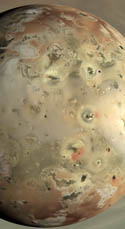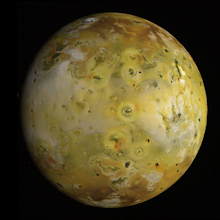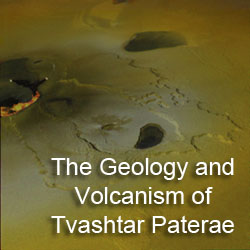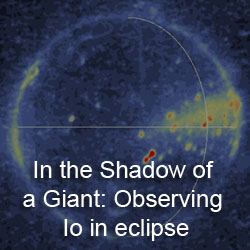 Last Wednesday, the abstracts for this year's Lunar and Planetary Science Conference were posted online and since then I have been discussing a few of these abstracts here on this blog, including ones on the new global geologic map to the stability of patera margin slopes. Today we are going to take a quick look at an abstract by Glenn Veeder, Ashley Davies, Dennis Matson, Torrence Johnson, Dave Williams, and Jani Radebaugh titled, "Io: The Dark Paterae Component of Heat Flow". In this abstract, the authors discuss new thermal modeling work based Galileo NIMS, SSI, and PPR infrared data and the USGS global basemap. This modeling was done to determine the contribution to Io's heat flow made by dark material on the floor of volcanic depressions known as paterae.
Last Wednesday, the abstracts for this year's Lunar and Planetary Science Conference were posted online and since then I have been discussing a few of these abstracts here on this blog, including ones on the new global geologic map to the stability of patera margin slopes. Today we are going to take a quick look at an abstract by Glenn Veeder, Ashley Davies, Dennis Matson, Torrence Johnson, Dave Williams, and Jani Radebaugh titled, "Io: The Dark Paterae Component of Heat Flow". In this abstract, the authors discuss new thermal modeling work based Galileo NIMS, SSI, and PPR infrared data and the USGS global basemap. This modeling was done to determine the contribution to Io's heat flow made by dark material on the floor of volcanic depressions known as paterae.Io's total heat flow, ~9.5×1013 W, has been measured from disk-integrated, ground-based IRTF data along with incomplete global data from Voyager IRIS and Galileo PPR. Galileo's SSI camera and NIMS near-infrared spectrometer acquired more complete global data (except over the polar regions), providing information on current or recently active volcanoes, but most of Io's heat flow is released at much longer infrared wavelengths from cooling lava flows, wavelengths IRTF, IRIS, and PPR were sensitive to. To inventory how Io's internal heat is released, the authors created a thermal model to estimate the amount of total energy released by volcanoes that are either outside of the terrain covered by IRIS or PPR, or were too small for those instruments to detect. In 2008 and 2009, this same group examined the contribution to Io's total heat flow from dark lava flows on the plains of Io (e.g. Amirani), both at LPSC in March 2008 and in a paper published in November 2009.
 For this research, the authors mapped the distribution of dark paterae floor materials across Io's surface and measured their areas. In total they found a total of 148,000 square kilometers, which is about 0.4% of Io's total surface area or a little less than the "dark patera floor" unit mapped by Williams et al. The authors found that the distribution of dark patera floor material has a similar bimodal distribution in longitude (with peaks near 130° W and 315° W) as paterae in general.
For this research, the authors mapped the distribution of dark paterae floor materials across Io's surface and measured their areas. In total they found a total of 148,000 square kilometers, which is about 0.4% of Io's total surface area or a little less than the "dark patera floor" unit mapped by Williams et al. The authors found that the distribution of dark patera floor material has a similar bimodal distribution in longitude (with peaks near 130° W and 315° W) as paterae in general.Of the total mapped area, 30,500 km2 are composed of a combination of Io's two largest dark floored paterae, Loki Patera (shown above) and Dazhbog Patera. The authors then took the areas of this dark patera floor material and using an effective temperature of that material, estimated their total power output. The total average power output of these two volcanoes was modeled to be 9.6×1012 W and 4.0×1012 W, respectively. In the case of Loki, this is 10% of Io's total heat flow. Both modeled power outputs are close to the measurements made by PPR. The other areas of dark paterae floor material account for six times that seen at Loki Patera, Io's most powerful volcano.
The abstract is part of research into how Io's internal heat is released, i.e. what heat sources make up Io's global heat flow. Assuming the same effective temperature for all these materials as Loki, dark paterae would account for 70% of Io's total heat flow (compared to 5% for dark flow fields on the Ionian plains like Masubi or Amirani). This makes dark paterae floor materials the most significant contributors to Io's heat flow.
Link: Io: The Dark Paterae Component of Heat Flow [www.lpi.usra.edu]










No comments:
Post a Comment